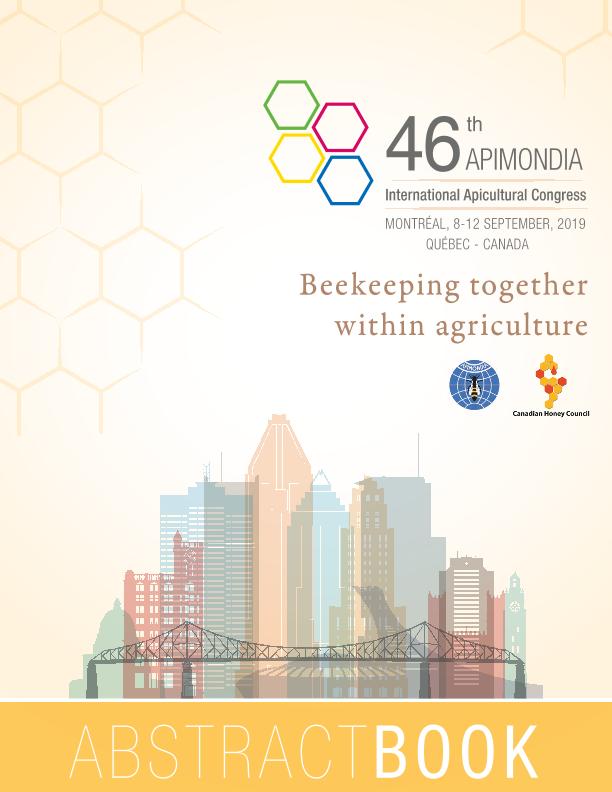Mostrar el registro sencillo del ítem
dc.contributor.author
Dowd, D. Duggan
dc.contributor.author
Muntaabski, Irina

dc.contributor.author
Russo, R. M.
dc.contributor.author
Landi, L.
dc.contributor.author
Lanzavecchia, S. B.
dc.contributor.author
Cladera, J. L.
dc.contributor.author
Palacio, M. A.
dc.contributor.author
Bedascarrabure, E.
dc.contributor.author
Scannapieco, Alejandra Carla

dc.contributor.author
Liendo, María Clara

dc.date.available
2022-10-20T20:24:09Z
dc.date.issued
2019
dc.identifier.citation
Understanding the differential hygienic behavior towards drone brood in Apis mellifera colonies from Argentina; 46th Apimondia International Apicultural Congress: Beekeeping together within agriculture; Québec; Canadá; 2019; 232-232
dc.identifier.isbn
978-88-944531-0-2
dc.identifier.uri
http://hdl.handle.net/11336/174270
dc.description.abstract
Brood diseases of Apis mellifera colonies constitute a main problem of beekeeping worldwide. Worker bees display a social health mechanism that consists in detecting, uncapping and removing dead or diseased brood from the hive: the hygienic behavior (CH). These activities are induced by olfactory cues and have been described as associated to hygiene of brood parasitized by Varroa destructor. This mite have preference for drone brood, but the efficiency of CH towards their cells is significantly lower compared with cells of worker brood, being left uninspected by workers. Some authors suggest that a possible cause of the CH differences is due to the cell wax cap of drone brood (thicker than worker cells) acting as a barrier to volatile compounds and obstructing disease detection. The aims of this research were to study the differential CH towards worker and drone brood belonging to highly hygienic colonies from Argentina, and to explore the importance of drone cell wax cap as an interfering factor in the transmission of chemical signals. To this end, removal percentages of pin-killed worker and drone brood were recorded and an innovative cell wax cap exchange was implemented in three different treatments: pin-killed worker pupa with a healthy drone cell wax cap; a healthy worker pupa with a pin-killed drone cell wax cap; and a healthy worker pupa covered with a healthy drone cell wax cap (control). Results showed a greater removal towards worker cells than drone cells. For the cell wax cap exchange experiment, we found that the removal of pin-killed worker pupae covered with healthy drone cell wax cap was significantly high, while the removal of healthy worker pupae covered with pin-killed drone opercula was low. These preliminary results confirms a differential behavior between both type of brood cells and suggests that the cell wax cap of drone brood is not interfering the detection of chemical compounds from the diseased brood by worker bees, regardless the thickness. This work contributes to a better understanding of the detection activity of different types of diseased brood and provides information useful to control strategies of varroosis and other brood diseases.
dc.format
application/pdf
dc.language.iso
eng
dc.publisher
International Federation of Beekeepers' Associations
dc.rights
info:eu-repo/semantics/openAccess
dc.rights.uri
https://creativecommons.org/licenses/by-nc-sa/2.5/ar/
dc.subject
HYGIENIC BEHAVIOR
dc.subject
DRONE
dc.subject
CELL WAX CAP
dc.subject
PIN-KILLED
dc.subject.classification
Zoología, Ornitología, Entomología, Etología

dc.subject.classification
Ciencias Biológicas

dc.subject.classification
CIENCIAS NATURALES Y EXACTAS

dc.title
Understanding the differential hygienic behavior towards drone brood in Apis mellifera colonies from Argentina
dc.type
info:eu-repo/semantics/publishedVersion
dc.type
info:eu-repo/semantics/conferenceObject
dc.type
info:ar-repo/semantics/documento de conferencia
dc.date.updated
2022-10-20T19:55:44Z
dc.journal.pagination
232-232
dc.journal.pais
Canadá

dc.journal.ciudad
Montreal
dc.description.fil
Fil: Dowd, D. Duggan. Instituto Nacional de Tecnología Agropecuaria. Centro de Investigación en Ciencias Veterinarias y Agronómicas. Instituto de Genética; Argentina
dc.description.fil
Fil: Muntaabski, Irina. Instituto Nacional de Tecnologia Agropecuaria. Centro de Investigacion En Ciencias Veterinarias y Agronomicas. Instituto de Agrobiotecnologia y Biologia Molecular. Grupo Vinculado Instituto de Genetica "ewald A. Favret" Al Iabimo | Consejo Nacional de Investigaciones Cientificas y Tecnicas. Oficina de Coordinacion Administrativa Pque. Centenario. Instituto de Agrobiotecnologia y Biologia Molecular. Grupo Vinculado Instituto de Genetica "ewald A. Favret" Al Iabimo.; Argentina
dc.description.fil
Fil: Russo, R. M.. Instituto Nacional de Tecnología Agropecuaria. Centro de Investigación en Ciencias Veterinarias y Agronómicas. Instituto de Genética; Argentina
dc.description.fil
Fil: Landi, L.. Instituto Nacional de Tecnología Agropecuaria. Centro de Investigación de Recursos Naturales. Instituto de Recursos Biológicos; Argentina
dc.description.fil
Fil: Lanzavecchia, S. B.. Instituto Nacional de Tecnología Agropecuaria. Centro de Investigación en Ciencias Veterinarias y Agronómicas. Instituto de Genética; Argentina
dc.description.fil
Fil: Cladera, J. L.. Instituto Nacional de Tecnología Agropecuaria. Centro de Investigación en Ciencias Veterinarias y Agronómicas. Instituto de Genética; Argentina
dc.description.fil
Fil: Palacio, M. A.. Instituto Nacional de Tecnología Agropecuaria; Argentina
dc.description.fil
Fil: Bedascarrabure, E.. Instituto Nacional de Tecnologia Agropecuaria. Centro de Investigacion de Agroindustria. Instituto de Ingeniería Rural.; Argentina
dc.description.fil
Fil: Scannapieco, Alejandra Carla. Instituto Nacional de Tecnologia Agropecuaria. Centro de Investigacion En Ciencias Veterinarias y Agronomicas. Instituto de Agrobiotecnologia y Biologia Molecular. Grupo Vinculado Instituto de Genetica "ewald A. Favret" Al Iabimo | Consejo Nacional de Investigaciones Cientificas y Tecnicas. Oficina de Coordinacion Administrativa Pque. Centenario. Instituto de Agrobiotecnologia y Biologia Molecular. Grupo Vinculado Instituto de Genetica "ewald A. Favret" Al Iabimo.; Argentina
dc.description.fil
Fil: Liendo, María Clara. Instituto Nacional de Tecnologia Agropecuaria. Centro de Investigacion En Ciencias Veterinarias y Agronomicas. Instituto de Agrobiotecnologia y Biologia Molecular. Grupo Vinculado Instituto de Genetica "ewald A. Favret" Al Iabimo | Consejo Nacional de Investigaciones Cientificas y Tecnicas. Oficina de Coordinacion Administrativa Pque. Centenario. Instituto de Agrobiotecnologia y Biologia Molecular. Grupo Vinculado Instituto de Genetica "ewald A. Favret" Al Iabimo.; Argentina
dc.relation.alternativeid
info:eu-repo/semantics/altIdentifier/url/https://www.apimondia.org/congress-2019.html
dc.conicet.rol
Autor

dc.conicet.rol
Autor

dc.conicet.rol
Autor

dc.conicet.rol
Autor

dc.conicet.rol
Autor

dc.conicet.rol
Autor

dc.conicet.rol
Autor

dc.conicet.rol
Autor

dc.conicet.rol
Autor

dc.conicet.rol
Autor

dc.coverage
Internacional
dc.type.subtype
Congreso
dc.description.nombreEvento
46th Apimondia International Apicultural Congress: Beekeeping together within agriculture
dc.date.evento
2019-09-08
dc.description.ciudadEvento
Québec
dc.description.paisEvento
Canadá

dc.type.publicacion
Book
dc.description.institucionOrganizadora
International Federation of Beekeepers' Associations
dc.description.institucionOrganizadora
Canadian Honey Council
dc.source.libro
46th Apimondia International Apicultural Congress: Abstract Book
dc.date.eventoHasta
2019-09-12
dc.type
Congreso
Archivos asociados
